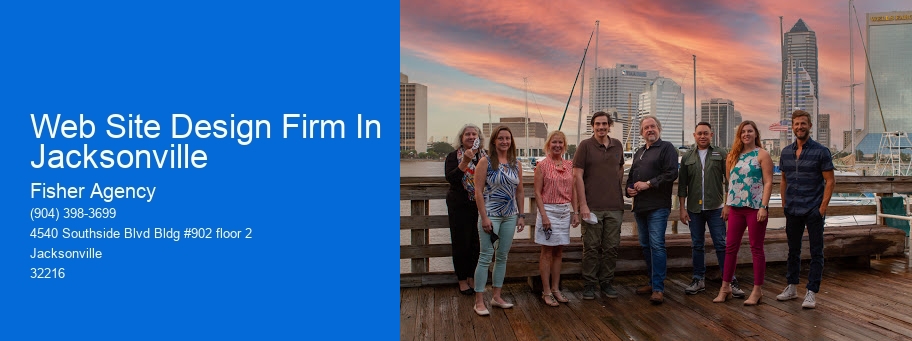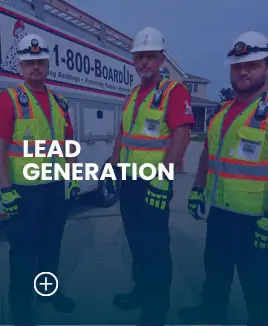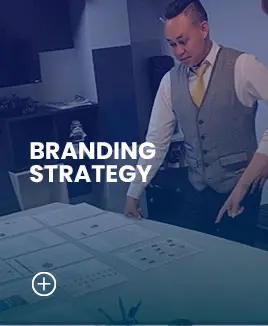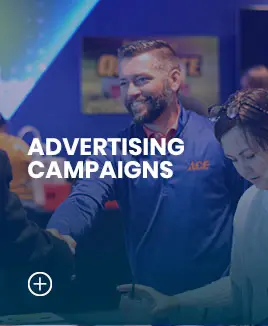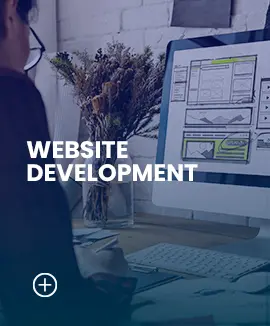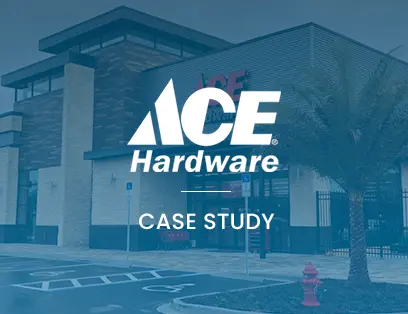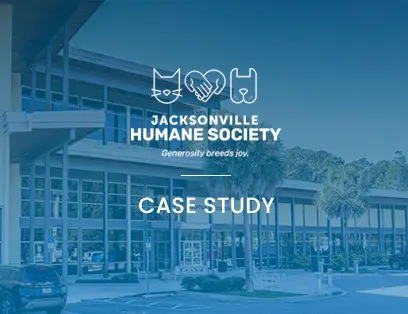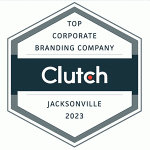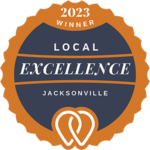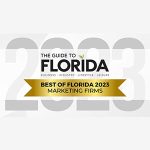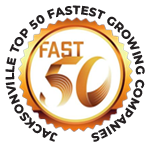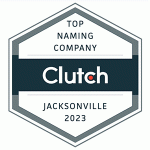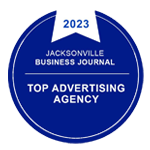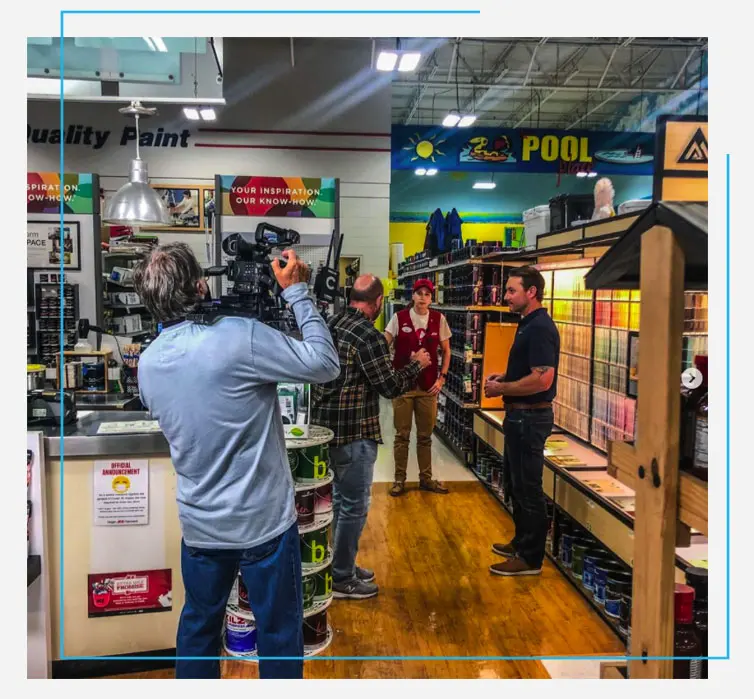Are you looking to grow your business through lead generation? Maybe you need a fresh new brand to increase leads. At Fisher Agency, a top marketing and design agency based in Jacksonville, FL, we have some of the best marketing strategies that will help you hook new clients. It doesn’t matter if you’re a Fortune 500 company or a small business; we can find the marketing angle that works best for you. If you are looking for web design, we do that. If you are looking for branding and logo design, we do that. And, if you are looking for digital marketing, we do that, too. In fact, we can put together a comprehensive marketing plan to determine the most cost-effective advertising strategies for you.
Web Site Design Firm In Jacksonville: Efficient Web Creation Enhances Online Existence
User Interface (UI) and User Experience (UX) Design: The Heart of Website Style
Ever arrived on a site and immediately felt lost? Or maybe you were constantly frustrated looking for what you needed? That's frequently the outcome of overlooking User User interface (UI) and User Experience (UX) style (Fisher Agency). Think of strolling into a shop where the items are spread randomly, and the signs are puzzling. You 'd most likely turn around and leave? The very same is real for sites. A confusing or clunky website style can result in high bounce rates and missed out on opportunities. User experience is not practically looks; it has to do with developing a smooth, intuitive journey for your visitors. It has to do with comprehending their needs and crafting a website that expects and fulfills those needs easily
The Obstacles of Disregarding UI/UX
Creating a site that is both aesthetically appealing and simple to utilize can be a complex endeavor. Lots of services battle with:
- Navigation Issues: Visitors can't discover what they're looking for. Imagine a possible client desperately trying to locate your services page, just to quit after limitless scrolling and clicking.
- Poor Mobile Responsiveness: In today's mobile-first world, a site that does not adjust to different screen sizes is a major turnoff. It resembles trying to fit a square peg in a round hole-- it just does not work.
- Inconsistent Branding: A disjointed visual experience can puzzle visitors and dilute your brand name identity. Think about it as sending out combined signals-- are you expert or lively? Reliable or experimental?
- Slow Loading Times: In the age of immediate gratification, slow packing times are a death knell for websites. Every second counts, and a hold-up can send out visitors running to your rivals.
Fisher Agency: Crafting Exceptional Digital Experiences
At Fisher Agency, we understand that site design is more than simply developing a pretty page; it's about crafting an experience. We dive deep into understanding your target audience, their behaviors, and their needs. We then equate this understanding into a visually stunning and extremely practical site that drives results. We don't just build websites; we build digital experiences that mesmerize, engage, and transform.
Our Method to UI/UX
We think that excellent UI/UX is the cornerstone of reliable website design. Here's how we ensure your site sticks out:
- User-Centric Design: We put your users at the heart of whatever we do. Our styles are based on extensive user research study and testing, guaranteeing that your site fulfills their requirements and expectations.
- Instinctive Navigation: We develop clear and rational navigation structures that make it easy for visitors to find what they're looking for. Bid farewell to frustrating dead ends and hello to smooth surfing.
- Mobile-First Approach: We create with mobile in mind, ensuring that your website looks and operates flawlessly on all devices. Reach your audience wherever they are, whenever they want.
- Brand Consistency: We guarantee that your website shows your brand name identity, developing a cohesive and unforgettable experience for your visitors. Develop trust and recognition with a constant visual presence.
- Performance Optimization: We enhance your website for speed and efficiency, making sure that it loads quickly and runs efficiently. Keep your visitors engaged and minimize bounce rates with a lightning-fast experience.
With Fisher Agency, you're not simply getting a site; you're getting a strategic tool created to accomplish your service objectives. Let us assist you create a digital experience that sets you apart from the competitors and drives significant outcomes. It's time to turn your site into a powerful asset that works for you, not versus you.
Info Architecture: The Blueprint of Your Site
Ever strolled into a home where you couldn't discover the light switch? Aggravating? That's what a badly prepared website seems like. Information Architecture (IA) is everything about structuring and arranging your site's material so users can find what they need quickly and easily.
Consider IA as the plan for your digital home. It determines how pages are arranged, identified, and connected together. A strong IA makes sure a seamless and user-friendly user experience, assisting visitors effortlessly through your site.
Secret Components of Info Architecture
- Organization Systems: How you classify your material. (e.g., by topic, audience, task)
- Labeling Systems: The words you utilize to represent your material. (Clear, concise, and consistent labels are key.)
- Navigation Systems: How users move around your site. (e.g., menus, breadcrumbs, search)
- Browse Systems: How users discover specific material. (A robust search function is essential.)
So, how do you avoid the digital equivalent of a complicated labyrinth? It begins with understanding your audience.
What are their objectives? What info are they looking for? Performing user research study and developing user personas can provide important insights. It's about designing the structure of the site with the user in mind, so that the user can browse the website with ease utilizing the navigation system.
Content Strategy: More Than Just Words
Content is king, they state. Even a king requires a kingdom, or in this case, a strategy. Content technique is the preparation, development, and management of content-- not simply words, however likewise images, videos, and other media.
A strong content technique guarantees that your material is not only interesting and useful but also aligned with your business objectives. It's about developing the ideal content, for the right individuals, at the best time. Imagine publishing article that never ever get checked out or creating item descriptions that confuse your consumers; this is a typical error and something to prevent.
Crafting a Winning Material Method
- Specify Your Audience: Know who you're talking with and what they want.
- Set Clear Goals: What do you desire your material to achieve? (e.g., produce leads, boost brand name awareness)
- Establish a Content Calendar: Plan your material production and publishing schedule.
- Step Your Outcomes: Track your material's efficiency and make modifications as needed.
However here's where things typically go awry: many services battle to align their content with their website design and user experience. They wind up with a gorgeous site that's filled with irrelevant or poorly written material. Or, they have terrific content that's buried deep within a complicated site structure. It's a dish for aggravation ... and lost opportunities.
Fisher Agency understands this problem. They do not just build sites; they craft digital experiences. Their team of IA experts and content strategists work hand-in-hand to ensure that your site is not just visually appealing but likewise simple to browse and filled with valuable content that resonates with your audience. They guarantee that the user interface is instinctive, and the content is engaging.
They dive deep into understanding your service objectives, your target audience, and your distinct worth proposal. They develop a custom IA and content strategy that lines up perfectly with your requirements. They are the option to all of your problems!
Visual Style Principles: The Soul of a Website
Ever arrived on a website that felt ... off? That gnawing experience often comes down to broken visual style concepts. These concepts aren't arbitrary rules; they're the bedrock of reliable communication. Think of them as the grammar of the visual language you're using to speak to your audience. Without a strong grasp, your message can get lost in translation.
Balance: More Than Simply Symmetry
Balance isn't simply about mirroring components on either side of a page. It has to do with creating a sense of balance. Symmetrical balance evokes procedure, while asymmetrical balance, accomplished through contrasting components, can inject dynamism. Think about a website selling progressive art; wouldn't asymmetrical balance better show its spirit?
Focus: Assisting the Eye
What do you desire visitors to see? Focus is how you accomplish that. Size, color, contrast-- these are your tools. However be careful the trap of over-emphasis! When whatever screams for attention, nothing is heard.
Rhythm and Movement: Creating a Visual Flow
Rhythm, in visual style, resembles the beat in music. It guides the eye and creates a sense of movement. Repetition of elements, variations in spacing, and strategic use of lines can establish a visual rhythm that makes the user experience more engaging.
Percentage and Scale: Developing Hierarchy
Proportion dictates the relative size and scale of aspects. A larger headline immediately signals value. Out of proportion components, when utilized intentionally, can produce stress and draw attention. It's a fragile dance.
Unity and Consistency: A Cohesive Whole
Unity is the glue that binds all the components together. Harmony ensures that these components interact aesthetically. A consistent color scheme, typography, and images are vital for attaining unity and consistency. A site that does not have unity feels disjointed and unprofessional.
Elements of Visual Design: The Structure Obstructs
Concepts are the "how," components are the "what." These are the raw materials you'll be dealing with.
- Line: Specifies shape, creates texture, and leads the eye.
- Forming: Conveys significance and adds interest.
- Color: Evokes emotion and establishes brand identity. Did you know specific colors are perceived in a different way across cultures?
- Texture: Includes depth and realism.
- Area: Produces balance and permits aspects to breathe.
These aspects aren't just ornamental; they are functional. They add to the total use and efficiency of your site.
Case Study: When Visual Style Goes Incorrect
I as soon as consulted with a customer whose site was a visual cacophony. A lot of font styles, clashing colors, and a total neglect for white space. The underlying issue was an absence of understanding of visual style concepts. They were so concentrated on packing in material that they forgot the user experience. The result? High bounce rates and miserable conversion rates.
The Fisher Agency understands this circumstance thoroughly. They understand that a website isn't simply a digital pamphlet; it's a vibrant tool for engaging clients and driving service outcomes. The Firm stands out at crafting visually stunning sites that also transform, focusing intently on the consistency in between aesthetic appeals and functionality.
One expert idea: numerous overlook the importance of micro-interactions. These subtle animations and feedback systems can significantly boost the user experience. Consider a button that changes color when hovered over or a development bar that supplies real-time feedback. These small information can make a big difference in user engagement and complete satisfaction. They likewise help with the perceived load times.
The Nuts and Bolts: Site Development Technologies
Ever seem like you're building a house on quicksand? That's how it can feel diving into site development without a strong foundation. It's not practically pretty pictures; the underlying structure is what keeps whatever upright and practical. Consider it as the plumbing and electrical work of your online existence. What good is a lovely faucet if no water comes out?
Front-End Frameworks: Where the Magic Takes place
The front-end is what your visitors see and communicate with. It's built with HTML, CSS, and JavaScript but typically counts on structures. These structures offer pre-written code and tools to streamline the advancement process. Ever observe how some sites feel smoother and more responsive than others? That's often the power of a well-chosen front-end structure at work. Respond, Angular, and Vue.js are a few of the huge players. Each has its strengths, and picking the best one can substantially impact your task's speed and maintainability.
- React: Understood for its component-based architecture and virtual DOM, making it effective for managing complex UIs.
- Angular: An extensive structure that offers a structured approach to building massive applications.
- Vue.js: A progressive framework that's easy to discover and incorporate, ideal for smaller tasks or adding interactivity to existing websites.
Back-End Technologies: Under the Hood
The back-end is the engine room of your site, managing data storage, user authentication, and server-side reasoning. This is where things get really interesting. Languages like Python, Java, and PHP are typically utilized, often in conjunction with databases like MySQL, PostgreSQL, or MongoDB. A properly designed back-end guarantees your website can handle traffic, process deals, and keep user data protect.
Material Management Systems (CMS): Taking Control
For lots of, a CMS like WordPress, Drupal, or Joomla is the favored path. CMS platforms use an user-friendly user interface for managing material without requiring to code. Do not be tricked; even with a CMS, comprehending the underlying innovations is crucial for modification and troubleshooting. Ever tried to modify a WordPress theme only to break your whole website? Yeah, that's why a little technical understanding goes a long method.
Dealing with Site Application Technological Obstacles
You have a vision for your site, but how do you make it a reality without getting lost in the technical weeds? It's a common struggle. The preliminary setup, the continuous updates, and the ever-evolving landscape of web innovations can feel frustrating. Lots of find themselves investing more time battling with code than concentrating on their actual organization. The Fisher Agency understands this accurate dilemma. They have a propensity for equating your vision into a functional and aesthetically pleasing website. They concentrate on the innovation so you can focus on your business, and they can assist you navigate the intricate world of web advancement, ensuring your website is not just lovely however likewise robust and scalable. They can take the problem off your shoulders, permitting you to concentrate on what you do best.
Site Style Solutions in Jacksonville, FL
Jacksonville, Florida, a lively city on the Atlantic coast, boasts a population of over 900,000 homeowners, making it the most populated city in Florida. Known for its stunning beaches, extensive park system, and growing business environment, Jacksonville offers a special mix of city amenities and natural charm. The city's strong economy, varied culture, and warm environment make it an appealing location to live and work.
For a complimentary consultation and specialist advice on Site Style, connect to Fisher Agency today - Fisher Agency. They can help you create a website that meets your particular needs and objectives
| Website Design | Designing a site's look and feel and UX is key to attracting and retaining visitors. Good Website Design improves a brand and guides users seamlessly through the digital realm. | https://en.wikipedia.org/wiki/Web_design |
| User Interface Design | User Interface Design emphasizes the visual components and interaction of a computerized product. A well-crafted UI is vital for creating captivating and user-friendly online experiences. | https://en.wikipedia.org/wiki/User_interface_design |
| User Experience | User Experience focuses on how people feel when interacting with a digital product. It plays a vital role in building engaging and efficient online presences. | https://en.wikipedia.org/wiki/User_experience_design |
| Responsive Web Design | Responsive Web Design guarantees the best viewing experience across different devices. It's crucial for creating adaptable digital interfaces. | https://en.wikipedia.org/wiki/Responsive_web_design |
| Html | HTML provides the structure and material for webpages. It is vital for making the visual design and engaging elements of online existence. | https://en.wikipedia.org/wiki/HTML |
| Css | Css dictates the visual appearance of online content, governing elements like layout, colors, and fonts. This styling language is essential for creating appealing and user-friendly digital experiences. | https://en.wikipedia.org/wiki/CSS |
| Javascript | Javascript enlivens web pages, rendering them interactive and lively. It's essential for creating captivating user interactions in online environments. | https://en.wikipedia.org/wiki/JavaScript |
| Web Accessibility | Web Accessibility guarantees digital content is usable by everyone, comprising people with disabilities. Integrating accessibility from the beginning of development results in more inclusive and user-friendly online experiences. | https://en.wikipedia.org/wiki/Web_accessibility |
| Web Development | Web Development is the creation and upkeep of sites on the internet, ensuring performance and user experience. It is essential for setting up an online presence and crafting interesting digital stages. | https://en.wikipedia.org/wiki/Web_development |
| Content Management System | The Content Management System (CMS) aids in creating, administering, and altering digital content. It allows users to construct and maintain a online presence without requiring any code. | https://en.wikipedia.org/wiki/Content_management_system |
| Search Engine Optimization | Search Engine Optimization enhances online presence through well-planned content and technical alterations. This procedure is vital to improve a site's ranking and draw in more organic traffic, resulting in increased success for any online venture. | https://en.wikipedia.org/wiki/Search_engine_optimization |
| Wireframe | Wireframes are basic layouts that outline a digital product's structure and features. They are essential for mapping user flows and content structure before visual design begins for online platforms. | https://en.wikipedia.org/wiki/Wireframe_model |
| Prototype | An Prototype is a preliminarily model of a system, used to test and improve its functionality and user experience. In interactive application development, prototypes allow designers to envision the design and progression of content before final development. | https://en.wikipedia.org/wiki/Website_wireframe |
| Bootstrap Framework | Bootstrap is a popular opensource framework for developing responsive, mobile first web applications. It offers pre-built components and tools that streamline the procedure of making uniform and visually appealing online presences. | https://en.wikipedia.org/wiki/Bootstrap_(front-end_framework) |
| Front End Development | Front End Development centers on creating the user interface and engaging elements of a website. It shapes the appearance and user experience of web applications. | https://en.wikipedia.org/wiki/Web_development |
| Back End Development | Back End Development is the engine that drives the functionality and data administration of web applications. It guarantees seamless user experiences by handling server-side logic, databases, and APIs. | https://en.wikipedia.org/wiki/Software_development |
| Hypertext Transfer Protocol | Hypertext Transfer Protocol is the foundation for data communications on the web, allowing browsers to ask for and receive resources from servers. It dictates how content is delivered, influencing the framework and presentation of online works. | https://en.wikipedia.org/wiki/Hypertext_Transfer_Protocol |
| Domain Name System | The Domain Name System converts user-friendly names into IP addresses, guiding users to the correct server. This is essential for online presence creation, making sure people can easily find and access content. | https://en.wikipedia.org/wiki/Domain_Name_System |
| Web Hosting | Web Hosting offers the required server storage and infrastructure for your site to be accessible on the internet. This is a foundational component that enables the design to reach its target audience. | https://en.wikipedia.org/wiki/Web_hosting_service |
| Cross Browser Compatibility | Cross Browser Compatibility ensures a stable user experience across various web browsers. It's vital for attracting a wider audience and maintaining the planned appearance and function of web products. | https://en.wikipedia.org/wiki/Cross-browser_compatibility |
| Mobile First Design | Mobile-first design prioritizes creating layouts and functionality for more compact screens first. This method ensures great user interactions on all devices while developing online platforms. | https://en.wikipedia.org/wiki/Responsive_web_design |
| Conversion Rate Optimization | Conversion Rate Optimization (CRO) improves the user experience to direct more visitors to intended actions. Implementing CRO strategies is essential for boosting the performance of an online presence and maximizing its potential. | https://en.wikipedia.org/wiki/Website_optimization |
| Typography | Typography substantially impacts user experience by making content readable and engaging on digital interfaces. It creates visual hierarchy and brand identity, affecting how visitors perceive and interact with the platform. | https://en.wikipedia.org/wiki/Typography |
| Color Theory | Color Theory steers artistic choices, influencing user perception and engagement. Strategic application of color principles enhances visual appeal and user experience for digital interfaces. | https://en.wikipedia.org/wiki/Color_theory |
| Information Architecture | Information Architecture organizes and structures content to ensure ease of use and discoverability. It's vital for developing successful digital interactions. | https://en.wikipedia.org/wiki/Information_architecture |
| User Centered Design | User Centered Design prioritizes the target audience's needs and preferences throughout the creation process. This approach ensures digital platforms are intuitive, accessible, and effective for their target users. | https://en.wikipedia.org/wiki/User-centered_design |
| Human Computer Interaction | Human-Computer Interaction principles guide the creation of user-friendly digital interfaces. Considering these principles results in more intuitive and efficient online experiences. | https://en.wikipedia.org/wiki/Human%E2%80%93computer_interaction |
| Usability | Usability ensures a site is easy to navigate and understand. It's crucial for developing interesting online experiences that meet user needs efficiently. | https://en.wikipedia.org/wiki/Usability |
| Prototyping | Prototyping is essential for imagining and evaluating interactive layouts before full development. It aids in refine user experience and detect likely issues early in the digital interface creation process. | https://en.wikipedia.org/wiki/Website_wireframe |
| Interaction Design | Interaction Design determines how users interact with digital interfaces. It's vital for developing intuitive and pleasant online experiences. | https://en.wikipedia.org/wiki/Interaction_design |
| Visual Design | Visual design focuses on the aesthetic appeal and user-friendliness of online interfaces. It molds user experience, guiding users through content with well-made layouts and engaging visuals for optimal interaction. | https://en.wikipedia.org/wiki/Graphic_design |
| Accessibility | Accessibility ensures digital content is usable by everyone, irrespective of ability. Focusing on it in development forms inclusive online experiences for all users. | https://en.wikipedia.org/wiki/Web_accessibility |
| User Research | User Research informs the process of developing useful online platforms by comprehending user requirements and actions. This understanding ensures that the digital product satisfies user expectations and reaches its desired purpose. | https://en.wikipedia.org/wiki/User_research |
| User Testing | User feedback shows how actual people use a digital product, finding usability issues and informing improvements. This feedback is crucial for creating impactful and user-centered online experiences. | https://en.wikipedia.org/wiki/Usability_testing |
| Navigation Design | Navigational design directs users through online interfaces, ensuring simple access to desired content. It's essential for good user experiences and efficient online property use. | https://en.wikipedia.org/wiki/Website_navigation |
| Call To Action | An Call To Action inspires users to perform a particular action. This is vital for leading visitors and obtaining goals on a digital platform. | https://en.wikipedia.org/wiki/Call_to_action |
| Layout Design | Layout Design organizes elements well and attractively. It's vital for creating engaging and user-friendly online presentations. | https://en.wikipedia.org/wiki/Web_design |
| Content Strategy | Content Strategy guides the planning, creation, delivery, and governance of helpful and practical content. It ensures that content aligns with user requirements and business goals, shaping the overall digital existence. | https://en.wikipedia.org/wiki/Content_strategy |
| Design Patterns | Design Patterns are easily usable answers to frequent software development problems. They make easier the creation of websites by providing proven architectural blueprints. | https://en.wikipedia.org/wiki/Software_design_pattern |
| Heuristic Evaluation | Heuristic Evaluation assesses a user interface usability according to established principles. It aids identify and correct design flaws in interactive systems, enhancing the general user experience and satisfaction. | https://en.wikipedia.org/wiki/Heuristic_evaluation |
| Cognitive Load | Cognitive Load concerns the intellectual exertion needed to process information. Reducing needless Cognitive Load is essential for creating user-friendly digital interfaces. | https://en.wikipedia.org/wiki/Cognitive_load |
| User Persona | User profiles are made-up, representative users that help guide decisions about site creation. They ensure the final product meets target audience needs and goals, leading to a more successful and user-centered digital experience. | https://en.wikipedia.org/wiki/Persona_(user_experience) |
| User Interface | User Interface is the point of interaction between a user and a digital product. It plays a vital role in how visitors perceive and utilize online platforms. | https://en.wikipedia.org/wiki/User_interface_design |
| Persona | Personas are fictional characterizations of ideal users, shaping content and layout decisions. They help adapt digital experiences to fulfill audience needs and improve engagement. | https://en.wikipedia.org/wiki/Persona_(user_experience) |
| A/B Testing | A/B Testing evaluates a pair of types of a webpage to figure out which functions superior with users. This data-driven method helps optimize digital experiences for transactions and participation. | https://en.wikipedia.org/wiki/A/B_testing |
| User Journey | User Journey maps show how users interact with a product or service, outlining their experiences and pain points. Understanding these journeys is crucial for developing easy-to-use and successful online platforms. | https://en.wikipedia.org/wiki/Customer_journey |
| Task Analysis | Task Analysis identifies user goals and divides them into more manageable steps. This informs the development of efficient and easy-to-use online platforms. | https://en.wikipedia.org/wiki/Task_analysis |
| Click Through Rate | CTR measures how often users select a particular link relative to how many times they view it. A strong CTR shows effective online interface arrangement and content, causing increased user engagement. | https://en.wikipedia.org/wiki/Click-through_rate |
| Customer Experience | Customer Experience shapes how users see a brand and its products. Positive digital engagements are crucial for engagement and sales on online platforms. | https://en.wikipedia.org/wiki/User_experience |
| Media Query | Media Queries allow information adaptation for different display dimensions and device capabilities. This guarantees the best user experience across different devices when viewing information online. | https://en.wikipedia.org/wiki/Responsive_web_design |
| Viewport | This Viewport governs how the site's content adjusts on different screens. Configuring it correctly assures the best viewing experience across various devices when creating for the internet. | https://en.wikipedia.org/wiki/Viewport |
| Flexible Grid Layout | Flexible Grid Layouts offer a flexible framework for arranging information. They guarantee best viewing experiences across various platforms and screen dimensions, enhancing online presence. | https://en.wikipedia.org/wiki/Responsive_web_design |
| Flexible Images | Adaptable pictures adjust to assorted screen dimensions, preserving visual appeal and averting layout breakage. They are crucial for ensuring a positive user experience on assorted devices during online platform creation. Flexible Images | https://en.wikipedia.org/wiki/Responsive_web_design |
| Fluid Layout | Flexible layouts adapt to various screen dimensions, providing an ideal viewing experience across devices. This adaptability is critical for modern digital interfaces. | https://en.wikipedia.org/wiki/Responsive_web_design |
| Progressive Enhancement | Progressive Enhancement is a plan for creating applications that centers on essential functionality first, then including enhancements for users with more advanced browsers and internet connections. This method ensures fundamental content and features are available to everyone, while providing an improved experience for those with newer technology. | https://en.wikipedia.org/wiki/Progressive_enhancement |
| Bootstrap | Bootstrap is a popular open-source framework for developing adaptable, mobile-oriented online experiences. It offers ready-made components and tools that expedite the process of designing interfaces for the web. | https://en.wikipedia.org/wiki/Bootstrap_(front-end_framework) |
| Foundation Framework | Foundation Framework is a responsive front-end framework that provides a grid structure, ready-made components, and templates. It simplifies the procedure of developing user interfaces for online platforms. | https://en.wikipedia.org/wiki/Foundation_(framework) |
| Web Standards | Web Standards guarantee compatibility and reachability across different browsers and devices. They offer a consistent foundation for creating online content, promoting a better user experience. | https://en.wikipedia.org/wiki/Web_standards |
| Screen Resolution | Screen Resolution impacts how content displays, affecting the visual elements and user experience. Adjusting to different screen sizes is essential for the best digital presentation. | https://en.wikipedia.org/wiki/Display_resolution |
| Adaptive Web Design | Adaptive Web Design crafts experiences that adapt to different display sizes and devices. This method guarantees online content remains reachable and user-friendly across different platforms. | https://en.wikipedia.org/wiki/Responsive_web_design |
| Touchscreen | Touchscreens have revolutionized how users interact with online content. Their reactivity and natural gestures shape digital experiences for seeing on any type of screen. | https://en.wikipedia.org/wiki/Touchscreen |
| Breakpoints | Breakpoints are key in responsive layouts, enabling content to adjust fluidly to various screen sizes. They guarantee ideal viewing experiences across different devices while building digital interfaces. | https://en.wikipedia.org/wiki/Responsive_web_design |
| Progressive Web App | Progressive Web Apps enrich user experience by providing app-like features directly through web browsers. They increase user engagement and accessibility for online presences. | https://en.wikipedia.org/wiki/Progressive_web_applications |
| Hypertext Markup Language | Hypertext Markup Language arranges and shows content on the web. It's the basis for making online presentations and engaging experiences. | https://en.wikipedia.org/wiki/HTML |
| Dom | The Document Object Model represents a page's structure, allowing dynamic content manipulation with code. It's crucial for interactive user experiences and modifying elements of a webpage. | https://en.wikipedia.org/wiki/Document_Object_Model |
| Web Browser | Web browsers remain essential for viewing and engaging with web based content, demonstrating how users will experience online platforms. Therefore, developers must consider browser compatibility to guarantee their web applications are accessible and work correctly across different platforms. | https://en.wikipedia.org/wiki/Web_browser |
| Html5 | Html5 is the base for organizing and presenting content on the internet. It enables developers to build engaging and dynamic online experiences. | https://en.wikipedia.org/wiki/HTML5 |
| W3C | The develops standards for the World Wide Web, guaranteeing compatibility and accessibility on different platforms. These standards greatly impact how online content is made and displayed. | https://en.wikipedia.org/wiki/World_Wide_Web_Consortium |
| Markup Language | Markup Languages provide the structure and content for digital interfaces. They are essential for organizing information and determining how it's displayed on the internet. | https://en.wikipedia.org/wiki/Markup_language |
| Semantic Html | Semantic Html employs semantic elements to structure information, boosting accessibility and SEO. This structured approach improves the visitor experience and entire site creation. | https://en.wikipedia.org/wiki/Semantic_HTML |
| Web Page | The Web Page is a key building block to online presence, providing content and functionality to users. Its meticulous arrangement and styling form the complete user experience of the digital platform. | https://en.wikipedia.org/wiki/Web_page |
| Hyperlink | Hyperlinks connect different pages, letting users to navigate content seamlessly. They are essential for establishing site structure and easy-to-use interfaces. | https://en.wikipedia.org/wiki/Hyperlink |
| Client Server Model | The Client Server Model permits users to ask for resources from a main server, providing interactive and dynamic digital experiences. The architecture is vital for building and delivering up-to-date online applications. | https://en.wikipedia.org/wiki/Client%E2%80%93server_model |
| Web Server | The Web Server provides content and functionality to users through the internet. It is a key component in organizing online presence and digital interfaces. | https://en.wikipedia.org/wiki/Web_server |
| Frontend Development | Frontend Development crafts the user interface and experience of web applications. It connects the gap between backend functionality and user interaction, shaping how people see and engage with online platforms. | https://en.wikipedia.org/wiki/Front-end_web_development |
| Web Typography | Web Typography is vital for developing beautiful and legible online content. Proper use of fonts and layout enhances user experience and strengthens a site's total aesthetic. | https://en.wikipedia.org/wiki/Typography |
| Media Queries | Media queries enable content adjustment depending on device attributes. This allows for responsive designs that offer the best viewing results across different screens. | https://en.wikipedia.org/wiki/Responsive_web_design |
| Web Forms | Web Forms are essential for user interaction, letting visitors to submit information and interact with a site. Their successful implementation significantly contributes to a positive user experience and general site presentation. | https://en.wikipedia.org/wiki/HTML_form |
| Cascading Style Sheets | Cascading Style Sheets governs the visual presentation of content organized with HTML. It manages aspects like layout, colors, and fonts, guaranteeing a uniform and engaging user interface for online platforms. | https://en.wikipedia.org/wiki/Cascading_Style_Sheets |
| Web Design | Web Design centers around the aesthetics and usability of online platforms. It shapes the user experience and overall attractiveness of digital presences. | https://en.wikipedia.org/wiki/Web_design |
| Box Model | The Box Model is a basic concept that defines how items are structured on a webpage. It dictates the content, padding, border, and margin of elements, affecting layout and spacing. | https://en.wikipedia.org/wiki/CSS_box_model |
| Flexbox | Flexbox is a CSS layout module that provides an efficient way to arrange, position, and allocate space between items in a container, even when their dimensions is unclear or changing. It's especially useful for developing responsive user UIs on various screen dimensions and device types. | https://en.wikipedia.org/wiki/CSS_flexible_box_layout |
| Grid Layout | Grid Layout is a potent CSS utility for designing intricate and responsive page layouts. It enables programmers to exactly control the placement and dimensions of items, leading to attractive and user-friendly digital experiences. | https://en.wikipedia.org/wiki/Grid_(graphic_design) |
| Selectors | The Selectors aim at specific HTML elements for styling. They are crucial for managing the look of online interfaces. | https://en.wikipedia.org/wiki/Selector_(CSS) |
| Properties | Characteristics define the look and behavior of elements, influencing layout, colors, and responsiveness. They are vital for crafting visually appealing and functional online experiences. | https://en.wikipedia.org/wiki/Web_design |
| Pseudo Classes | Pseudo Classes enhance styling by targeting elements based on their condition or position, not just HTML structure. This dynamic control improves user interface and interaction in digital development. | https://en.wikipedia.org/wiki/Pseudo-classes |
| Css Variables | Css Variables streamline styling, enabling efficient theming administration and consistent aesthetics throughout digital interfaces. These variables provide centralized control and easy modification of layout aspects. | https://en.wikipedia.org/wiki/CSS#Variables |
| Specificity | Specificity in styling states which CSS rules apply, making sure elements display as intended. It's crucial for managing conflicts and developing a reliable, sustainable user interface in digital platforms. | https://en.wikipedia.org/wiki/Web_design |
| Inheritance | Inheritance encourages code reuse and consistency by allowing design elements to inherit properties from parent components. This assures a streamlined and effective method to interface development. | https://en.wikipedia.org/wiki/Inheritance_(object-oriented_programming) |
| Css Frameworks | Css Frameworks simplify styling and structure, offering pre-built parts for crafting user UIs. These frameworks expedite development and guarantee uniformity across digital experiences. | https://en.wikipedia.org/wiki/CSS_framework |
| Sass | Sass, a is a CSS preprocessor that improves styling with features like variables and nesting. It streamlines the creation of complex and organized layouts for digital platforms. | https://en.wikipedia.org/wiki/Sass_(stylesheet_language) |
| Less | Less is a CSS preprocessor that extends the functionality of CSS, enabling developers to write more modular, easily maintained, and adaptive stylesheets. It simplifies the procedure of styling digital platforms and online sites by adding features like variables, mixins, and functions. | https://en.wikipedia.org/wiki/Minimalism_(computing) |
| Css Animations | Css Animations add life to UIs, enhancing user experience through engaging visual feedback. They have a vital role in creating vibrant and interactive digital experiences. | https://en.wikipedia.org/wiki/CSS |
| Transitions | Transitions enhance user experience by visually connecting various states or sections. Careful implementation leads users through interactive interfaces, improving engagement and navigation. | https://en.wikipedia.org/wiki/Website_wireframe |
| Document Object Model | The Document Object Model (DOM) is a programming interface for HTML and XML documents. It embodies the structure of a page, letting scripts to in real-time access and update content, structure, and styles, ultimately impacting constructing online presences. | https://en.wikipedia.org/wiki/Document_Object_Model |
| 32206 | 32206 is a zip code encompassing a diverse region of Jacksonville FL. It includes Arlington, known for its mid-century architecture and easy access to downtown. | https://en.wikipedia.org/wiki/Jacksonville,_Florida |
| 32207 | The 32207 zip code is a zip code encompassing parts of Jacksonville's Southside, recognized for its blend of residential areas and commercial developments. It includes diverse neighborhoods and convenient access to major roadways. Jacksonville FL | https://en.wikipedia.org/wiki/Jacksonville,_Florida |
| 32208 | 32208 is a postal code covering parts of Jacksonville FL's South Side, known for its mix of domestic districts and commercial centers. It includes famous spots like the Avenues Mall and adjacent business parks. | https://en.wikipedia.org/wiki/Jacksonville,_Florida |
| 32209 | 32209 is a zip code including sections of Arlington, a large and varied housing district in Jacksonville FL. It offers a combination of accommodation choices, parks, and easy entry to downtown. | https://en.wikipedia.org/wiki/Jacksonville,_Florida |
| 32210 | This zip code is a dynamic neighborhood in Jacksonville FL, famous for its blend of residential areas and commercial businesses. It provides a convenient location with simple access to highways and area resources. | https://en.wikipedia.org/wiki/Jacksonville,_Florida |
| 32211 | The 32211 postal code is a zip code primarily serving the Arlington district of Jacksonville FL. It is a sizable residential district with a mix of housing selections, retail businesses, and parks. | https://en.wikipedia.org/wiki/Jacksonville,_Florida |
| 32099 | The 32099 ZIP code encompasses Ponte Vedra Beach, a coastal community known for its high-end homes and golf courses. It offers beautiful beaches and a relaxed, resort-like atmosphere. | https://en.wikipedia.org/wiki/List_of_Jacksonville_neighborhoods |
| 32201 | 32201 is a downtown Jacksonville FL postal code encompassing the city center. It features sites such as the Jacksonville Landing and historic buildings. | https://en.wikipedia.org/wiki/Jacksonville,_Florida |
| 32202 | The 32202 ZIP code is a dynamic neighborhood in Jacksonville FL, known for its historical charm and eclectic community. It offers a mix of residential areas, local businesses, and cultural attractions. | https://en.wikipedia.org/wiki/Jacksonville,_Florida |
| 32203 | 32203 is a zip code encompassing a big portion of Jacksonville FL's city center district and surrounding neighborhoods. It contains many historic buildings, companies, and housing areas beside the St. Johns River. | https://en.wikipedia.org/wiki/Neighborhoods_of_Jacksonville |
| 32204 | The 32204 zip code is a zip code covering the neighborhood of Ortega in Jacksonville FL. It's a historical and wealthy area known for its water's edge properties and oak-lined streets. | https://en.wikipedia.org/wiki/Jacksonville,_Florida |
| 32205 | 32205 is a zip code encompassing a large part of Jacksonville FL's urban core, including the historical Riverside and Avondale neighborhoods. Known for its dynamic arts scene, diverse architecture, and walkable streets, 32205 presents a mix of residential, business, and recreational spaces. | https://en.wikipedia.org/wiki/List_of_Jacksonville_neighborhoods |
| 32212 | The 32212 area code is a zip code covering parts of Jacksonville FL's Southside, known for its mix of residential areas and commercial centers. It provides a range of housing options, retail, and dining experiences. | https://en.wikipedia.org/wiki/Jacksonville,_Florida |
| 32214 | This ZIP code is a zip code encompassing parts of Jacksonville's Southside, recognized for its mix of residential areas and commercial developments. It provides a blend of suburban living with easy access to shopping, dining, and major roadways. | https://en.wikipedia.org/wiki/Neighborhoods_of_Jacksonville |
| 32215 | 32215 is a zip code covering several neighborhoods in Jacksonville FL's Southside region. It's recognized for a mix of residential areas, business hubs, and closeness to important roads. | https://en.wikipedia.org/wiki/Jacksonville,_Florida |
| 32216 | That ZIP code is a zip code including parts of Jacksonville's Southside, noted for its mix of residential zones and commercial developments. It gives a suburban vibe with easy access to shopping, dining, and major roadways. | https://en.wikipedia.org/wiki/Jacksonville,_Florida |
| 32217 | 32217 is a zip code covering a big part of Mandarin, a suburb in Jacksonville FL known for its scenic waterfront scenes. It features a blend of residential areas, parks, and commercial developments along the St. Johns River. | https://en.wikipedia.org/wiki/Jacksonville,_Florida |
| 32218 | The 32218 is a zip code including parts of the Southside neighborhood in Jacksonville FL. It is a largely residential area with a combination of apartments, condos, and single-family homes. | https://en.wikipedia.org/wiki/Southside,_Jacksonville |
| 32227 | 32227 covers the Jacksonville Beach area, offering a mix of housing neighborhoods and beachfront attractions. It's recognized for its calm coastal lifestyle and popular surfing spots. Jacksonville FL | https://en.wikipedia.org/wiki/Jacksonville,_Florida |
| 32228 | 32228 is a zip code covering the Jacksonville FL area. It is recognized for its sandy beaches, lively boardwalk, and oceanfront leisure pursuits. | https://en.wikipedia.org/wiki/Jacksonville,_Florida |
| 32229 | 32229 is a zip code covering the Arlington district of Jacksonville FL. It is a large residential and commercial district situated east of the St. Johns River. | https://en.wikipedia.org/wiki/Jacksonville,_Florida |
| 32235 | 32235 is a zip code primarily covering the Arlington area of Jacksonville FL. It is a large residential area with a mix of housing options, retail, and commercial businesses. | https://en.wikipedia.org/wiki/Jacksonville,_Florida |
| 32236 | 32236 is a zip code covering the Ocean Way and New Berlin neighborhoods in Jacksonville FL. It's a mainly housing area known for its suburban character and closeness to the Jax International Airport. | https://en.wikipedia.org/wiki/Jacksonville,_Florida |
| 32237 | That ZIP code is a zip code covering a part of Jacksonville's Southside area. It's known for a combination of residential neighborhoods, business centers, and proximity to the University of North Florida. | https://en.wikipedia.org/wiki/Neighborhoods_of_Jacksonville |
| 32238 | 32238 is a zip code covering parts of Jacksonville FL's Southside, recognized for its blend of housing and commercial developments. It includes popular shopping centers, office parks, and diverse housing choices. | https://en.wikipedia.org/wiki/Neighborhoods_of_Jacksonville |
| 32239 | 32239 is a zip code including the Kernan area of Jacksonville FL. It is a burgeoning residential area with a blend of housing options and easy access to facilities. | https://en.wikipedia.org/wiki/Jacksonville,_Florida |
| 32240 | 32240 is a zip code covering the Argyle Forest neighborhood in Jacksonville FL. This region is known for its welcoming environment and suburban development. | https://en.wikipedia.org/wiki/Jacksonville,_Florida |
| 32241 | 32241 is a Jacksonville FL zip code covering the Southside Estates neighborhood. It is a mainly residential section with a combination of housing choices and easy access to major roadways. | https://en.wikipedia.org/wiki/Jacksonville,_Florida |
| 32244 | 32244 is a zip code encompassing the Jacksonville Beaches area. It includes Neptune Beach, Atlantic Beach, and some of Jacksonville Beach. | https://en.wikipedia.org/wiki/Jacksonville,_Florida |
| 32219 | 32219 is a zip code connected with the Mandarin area in Jacksonville FL. It's a large residential area known for its mix of established communities and more recent projects. | https://en.wikipedia.org/wiki/Jacksonville,_Florida |
| 32220 | The 32220 area code is a zip code covering the Argyle Forest neighborhood in Jacksonville FL. It's a mainly residential area recognized for its family-friendly atmosphere and easy access to shopping and dining. | https://en.wikipedia.org/wiki/Jacksonville,_Florida |
| 32221 | 32221 is a zip code covering parts of Jacksonville FL's Southside, known for its blend of housing developments and business parks. It includes communities like Baymeadows and Deerwood, providing a variety of housing and retail options. | https://en.wikipedia.org/wiki/Jacksonville,_Florida |
| 32222 | That zip code in Jacksonville, FL includes the Beach Haven and South Beach sections. This area is known for its closeness to the coast and residential communities. | https://en.wikipedia.org/wiki/Neighborhoods_of_Jacksonville |
| 32223 | 32223 is a zip code surrounding the tangerine neighborhood of Jacksonville FL. It is a large residential area known for its history, parks, and proximity to the St. Johns River. | https://en.wikipedia.org/wiki/Neighborhoods_of_Jacksonville |
| 32224 | 32224 is a zip code including Jacksonville Beach, a coastal community known for its sandy beaches. Residents and tourists alike enjoy surfing, angling, and a energetic promenade scene in Jacksonville FL. | https://en.wikipedia.org/wiki/Jacksonville,_Florida |
| 32225 | 32225 is a zip code encompassing Jacksonville FL's Southside area, recognized for its combination of residential locations, business centers, and closeness to the St. Johns River. It provides a mixture of outskirts living with easy access to stores, dining, and leisure activities. | https://en.wikipedia.org/wiki/Jacksonville,_Florida |
| 32226 | 32226 is a zip code encompassing the Southside area of Jacksonville FL. It is a big, varied region known for its commercial centers, housing developments, and closeness to the St. Johns River. | https://en.wikipedia.org/wiki/Jacksonville,_Florida |
| 32230 | 32230 is a zip code covering the Jacksonville FL communities of Arlington and Fort Caroline. This area offers a mix of housing developments, parks, and historical sites. | https://en.wikipedia.org/wiki/Jacksonville,_Florida |
| 32231 | 32231 is the zip code for Mandarin, a large suburban neighborhood in Jacksonville FL known for its history and picturesque views beside the St. Johns River. It provides a combination of residential areas, parks, and commercial centers. | https://en.wikipedia.org/wiki/Jacksonville,_Florida |
| 32232 | 32232 is the zip code of the Kernan area of Jacksonville FL. It is a growing suburban community recognized for its housing areas and closeness to the beach. | https://en.wikipedia.org/wiki/Neighborhoods_of_Jacksonville |
| 32234 | 32234 is the zip code of the Mandarin neighborhood in Jacksonville FL. It's a large housing location recognized for its past, parks, and proximity to the St. Johns River. | https://en.wikipedia.org/wiki/Jacksonville,_Florida |
| 32245 | 32245 is a zip code encompassing several neighborhoods in Jacksonville FL, including the wealthy Deerwood area known for its gated neighborhoods and the expansive St. Johns Town Center retail and restaurant destination. Locals can appreciate a mix of high-end living, retail accessibility, and proximity to major roadways. | https://en.wikipedia.org/wiki/Jacksonville,_Florida |
| 32246 | 32246 is a zip code covering the Hodges Boulevard area in Jacksonville FL. It's a mainly residential area with a mix of home choices and commercial developments. | https://en.wikipedia.org/wiki/Neighborhoods_of_Jacksonville |
| 32247 | 32247 is a zip code covering the Mandarin neighborhood in Jacksonville FL. It's a large residential area famous for its historical roots, waterfront scenery, and family-friendly environment. | https://en.wikipedia.org/wiki/Neighborhoods_of_Jacksonville |
| 32250 | The 32250 is a zip code encompassing a part of Jacksonville FL's Southside, recognized by its mix of residential areas and business expansions. It includes sections of the Baymeadows area, offering a variety of accommodation choices and easy entry to stores and dining. | https://en.wikipedia.org/wiki/Neighborhoods_of_Jacksonville |
| 32254 | 32254 is a zip code covering parts of Jacksonville FL's Southside, recognized for its mix of housing areas and business developments. It contains the well-known Deerwood Park and Tinseltown areas. | https://en.wikipedia.org/wiki/Neighborhoods_of_Jacksonville |
| 32255 | 32255 is a zip code encompassing various areas in Jacksonville FL's Southside area. It includes a blend of residential areas, commercial hubs, and closeness to major roadways. | https://en.wikipedia.org/wiki/Jacksonville,_Florida |
| 32256 | 32256 is a zip code covering sections of the Southside neighborhood in Jacksonville FL. It offers a combination of residential areas, business districts, and entertainment options. | https://en.wikipedia.org/wiki/Jacksonville,_Florida |
| 32257 | 32257 is a zip code covering the Kernan and Hodges Boulevards area of Jacksonville FL. This area is known for its residential communities, retail locations, and closeness to the University of North Florida. | https://en.wikipedia.org/wiki/Jacksonville,_Florida |
| 32258 | 32258 is a zip code encompassing portions of Jacksonville FL's south side, recognized for residential sections and commercial projects. It covers neighborhoods like Baymeadows and Deer Wood, offering a blend of lodging choices and handy entrance to purchasing and food. | https://en.wikipedia.org/wiki/Jacksonville,_Florida |
| 32260 | That zip code is a zip code encompassing Jacksonville FL's Southside area. It features a mix of housing, business properties, and proximity to the St. Johns River. | https://en.wikipedia.org/wiki/Jacksonville,_Florida |
| 32277 | 32277 is the zip code for Jacksonville FL, a coastal community known for its grainy shores and vibrant boardwalk. It provides a mix of residential areas, hotels, restaurants, and recreational activities. | https://en.wikipedia.org/wiki/Jacksonville,_Florida |
- Downtown Jacksonville: Downtown Jacksonville represents the central business district of Jacksonville, Florida, known for its vibrant mix of heritage architecture and state-of-the-art skyscrapers. It features cultural sites, waterfront parks, and a variety of dining and entertainment options.
- Southside: Southside is a lively district in Jacksonville, FL, known for its mix of residential communities, shopping centers, and business hubs. It offers a blend of urban convenience and residential comfort, making it a favored area for families and professionals.
- Northside: Northside is a extensive district in Jacksonville, FL, known for its diverse communities and industrial areas. It features a blend of residential neighborhoods, parks, and commercial zones, supporting the city's growth and development.
- Westside: Westside is a vibrant district in Jacksonville, FL, known for its varied community and deep cultural heritage. It features a mix of housing areas, shops, and parks, offering a unique blend of city and suburban life.
- Arlington: Arlington is a dynamic district in Jacksonville, FL, known for its blend of residential neighborhoods and commercial zones. It features parks, retail centers, and access to the St. Johns River, making it a favored area for households and nature lovers.
- Mandarin: Mandarin stands as a historic district in Jacksonville, Florida, known for its scenic riverfront views and quaint small-town atmosphere. It features lush parks, local shops, and a deep cultural heritage dating back to the 19th century.
- San Marco: San Marco is a dynamic neighborhood in Jacksonville, FL, known for its historic architecture and quaint town center. It offers a mix of unique shops, restaurants, and cultural attractions, making it a well-liked destination for residents and visitors alike.
- Riverside: Riverside is a dynamic community in Jacksonville, FL, known for its historic architecture and bustling arts scene. It offers a mix of one-of-a-kind shops, restaurants, and scenic riverfront parks, making it a favored destination for residents and visitors alike.
- Avondale: Avondale is a charming neighborhood in Jacksonville, FL, known for its classic architecture and lively local shops. It offers a blend of residential areas, stylish restaurants, and cultural attractions along the St. Johns River.
- Ortega: Ortega is a historic and picturesque neighborhood in Jacksonville, FL, known for its attractive waterfront homes and shady streets. It offers a pleasant blend of traditional Southern architecture and contemporary amenities, making it a desirable residential area.
- Murray Hill: Murray Hill is a vibrant historic neighborhood in Jacksonville, FL, known for its quaint bungalows and unique local businesses. It offers a blend of residential comfort and a lively arts and dining scene, making it a well-liked destination for residents and visitors alike.
- Springfield: Springfield is a historic neighborhood in Jacksonville, FL, known for its quaint early 20th-century architecture and vibrant community. It features a combination of residential homes, local businesses, and cultural attractions, making it a favored area for both residents and visitors.
- East Arlington: East Arlington is a lively neighborhood in Jacksonville, FL, known for its mixed community and convenient access to shopping and parks. It features a mix of residential homes, parks, and shops, making it a appealing place to live.
- Fort Caroline: Fort Caroline is a heritage district in Jacksonville, FL, known for its rich colonial history and proximity to the site of the 16th-century French fort. It includes a mix of residential areas, parks, and cultural landmarks that showcase its heritage.
- Greater Arlington: Greater Arlington in Jacksonville, FL, is a dynamic district known for its residential communities, shopping centers, and green spaces. It offers a mix of suburban living with convenient access to the Jacksonville downtown and beach areas.
- Intracoastal West: Intracoastal West is a dynamic neighborhood in Jacksonville, FL, known for its beautiful waterways and being near the Intracoastal Waterway. It offers a blend of homes and businesses, providing a unique blend of city convenience and natural charm.
- Jacksonville Beaches: Jacksonville Beaches is a vibrant coastal area in Jacksonville, FL, known for its lovely sandy shores and laid-back atmosphere. It provides a blend of residential neighborhoods, local shops, and recreational activities along the Atlantic Ocean.
- Neptune Beach: Neptune Beach is a pleasant coastal area located in Jacksonville, Florida, known for its stunning beaches and relaxed atmosphere. It offers a combination of housing areas, local shops, and dining options, making it a popular destination for both residents and visitors.
- Atlantic Beach: Atlantic Beach is a beachside community located in Jacksonville, Florida, known for its gorgeous beaches and relaxed atmosphere. It offers a combination of residential areas, local shops, and outdoor recreational activities along the Atlantic Ocean.
- Jackson Beach: Jacksonville Beach is a vibrant coastal community in Jacksonville, FL, known for its stunning beaches and bustling boardwalk. It offers a mix of residential neighborhoods, local shops, restaurants, and recreational activities, making it a favored destination for both residents and visitors.
- Baldwin: Baldwin is a modest town located within Duval County, near Jacksonville FL, FL, known for its charming charm and tight-knit community. It features a combination of housing areas, local businesses, and scenic parks, offering a calm, suburban atmosphere.
- Oceanway: Oceanway is a housing neighborhood in Jacksonville, Florida, known for its residential atmosphere and kid-friendly amenities. It features a variety of housing options, parks, and local businesses, making it a favored area for residents seeking a community-oriented environment.
- South Jacksonville: South Jacksonville is a lively district in Jacksonville, FL, known for its living communities and local shops. It offers a blend of historic character and up-to-date facilities, making it a popular area for families and working individuals.
- Deerwood: Deerwood is a well-known neighborhood in Jacksonville, FL, known for its high-end residential communities and manicured green spaces. It offers a mix of elegant homes, golf courses, and quick access to shopping and dining options.
- Baymeadows: Baymeadows is a vibrant district in Jacksonville, FL, known for its mix of residential neighborhoods and commercial areas. It offers a selection of shopping, dining, and recreational options, making it a favored destination for locals and visitors alike.
- Bartram Park: Bartram Park is a dynamic neighborhood in Jacksonville, FL, known for its modern residential communities and nearness to nature. It offers a blend of urban amenities and outdoor recreational opportunities, making it a well-liked choice for families and professionals.
- Nocatee: Nocatee is a planned community located near Jacksonville, FL, known for its kid-friendly atmosphere and comprehensive amenities. It features parks, trails, and recreational facilities, making it a popular choice for residents seeking a vibrant suburban lifestyle.
- Brooklyn: Brooklyn is a lively district in Jacksonville, FL, known for its historic charm and friendly community. It includes a blend of houses, shops, and cultural landmarks that reflect the area's cultural wealth.
- LaVilla: LaVilla is a historic area in Jacksonville FL, known because of its extensive heritage heritage and vibrant arts scene. Formerly a flourishing African American community, it had a major part in the city's music and entertainment past.
- Durkeeville: Durkeeville is a historic in Jacksonville, Florida, known for its strong African American heritage and lively community. It features a combination of residential areas, local businesses, and cultural landmarks that reflect its deep roots in the city's history.
- Fairfax: Fairfax is a dynamic neighborhood in Jacksonville, FL, known for its historic charm and tight-knit community. It features a mix of houses, local businesses, and open areas, offering a welcoming atmosphere for residents and guests alike.
- Lackawanna: Lackawanna is a housing neighborhood in Jacksonville, Florida, known for its tranquil streets and neighborly atmosphere. It features a mix of single-family homes and local businesses, contributing to its small-town feel within the city.
- New Town: New Town is a historic neighborhood in Jacksonville, FL, known for its strong community spirit and vast cultural heritage. It features a mix of residential areas, local businesses, and community organizations striving to revitalize and improve the district.
- Panama Park: Panama Park is a housing neighborhood in Jacksonville, FL, known for its quiet streets and neighborly atmosphere. It offers simple access to local facilities and parks, making it an attractive area for families and working individuals.
- Talleyrand: Talleyrand is a heritage neighborhood in Jacksonville, Florida, known for its housing charm and proximity to the St. Johns River. The area features a mix of older homes and local businesses, reflecting its strong community heritage.
- Dinsmore: Dinsmore is a living neighborhood located in Jacksonville, Florida, known for its quiet streets and neighborly atmosphere. It features a mix of single-family homes and local amenities, offering a neighborhood feel within the city.
- Garden City: Garden City is a vibrant neighborhood in Jacksonville, FL, known for its combination of residential homes and local businesses. It offers a close-knit community atmosphere with quick access to city amenities.
- Grand Park: Grand Park is a vibrant neighborhood in Jacksonville, Florida, known for its historic charm and mixed community. It features leafy streets, local parks, and a selection of small businesses that contribute to its welcoming atmosphere.
- Highlands: Highlands is a vibrant neighborhood in Jacksonville, FL known for its pleasant residential streets and local parks. It offers a combination of historic homes and modern amenities, creating a friendly community atmosphere.
- Lake Forest: Lake Forest is a housing neighborhood located in Jacksonville, Florida, known for its peaceful streets and kid-friendly atmosphere. It features a mix of private residences, parks, and local amenities, making it a desirable community for residents.
- Paxon: Paxon is a housing neighborhood located in the western part of Jacksonville, Florida, known for its diverse community and budget-friendly housing. It features a mix of detached houses and local businesses, contributing to its close-knit, suburban atmosphere.
- Ribault: Ribault is a dynamic neighborhood in Jacksonville, Florida, known for its varied community and neighborhood appeal. It features a mix of historic homes and local businesses, adding to its unique cultural identity.
- Sherwood Forest: Sherwood Forest is a housing neighborhood in Jacksonville, FL, known for its leafy streets and family-friendly atmosphere. It features a mix of traditional and new homes, offering a tranquil suburban feel close to city amenities.
- Whitehouse: Whitehouse is a housing neighborhood located in Jacksonville, Florida, known for its quiet streets and community-oriented atmosphere. It features a mix of individual residences and local amenities, making it a favored area for families and professionals.
- Cedar Hills: Cedar Hills is a vibrant neighborhood in Jacksonville, FL, known for its multicultural community and convenient access to local amenities. It offers a blend of residential and commercial areas, contributing to its energetic and welcoming environment.
- Grove Park: Grove Park is a residential neighborhood in Jacksonville, Florida, known for its delightful historic homes and canopied streets. It offers a friendly community atmosphere with quick access to downtown amenities and parks.
- Holiday Hill: Holiday Hill is a living neighborhood in Jacksonville, Florida, known for its quiet streets and tight-knit community. It offers convenient access to local parks, schools, and shopping centers, making it a appealing area for families.
- Southwind Lakes: Southwind Lakes is a housing neighborhood in Jacksonville, FL known for its serene lakes and well-maintained community spaces. It offers a calm suburban atmosphere with close access to local amenities and parks.
- Secret Cove: Secret Cove is a peaceful waterfront neighborhood in Jacksonville, FL, known for its calm atmosphere and beautiful views. It offers a mix of residential homes and natural landscapes, making it a popular spot for outdoor enthusiasts and families.
- Englewood: Englewood is a dynamic neighborhood in Jacksonville, FL, known for its diverse community and strong cultural heritage. It offers a combination of residential areas, local businesses, and recreational spaces, making it a active part of the city.
- St Nicholas: St. Nicholas is a historic neighborhood in Jacksonville, Florida, known for its delightful early 20th-century architecture and vibrant community atmosphere. It offers a blend of residential homes, local businesses, and cultural landmarks, making it a one-of-a-kind and inviting area within the city.
- San Jose: San Jose is a lively district in Jacksonville, FL, known for its residential neighborhoods and commercial areas. It offers a combination of suburban lifestyle with close proximity to parks, shopping, and dining.
- Pickwick Park: Pickwick Park is a residential neighborhood in Jacksonville, Florida, known for its quiet streets and neighborly atmosphere. It offers a mix of single-family homes and local amenities, making it a desirable area for families and professionals.
- Lakewood: Lakewood is a dynamic neighborhood in Jacksonville, FL known for its historic charm and diverse community. It features a combination of residences, local enterprises, and parks, offering a inviting atmosphere for residents and visitors alike.
- Galway: Galway is a housing neighborhood in Jacksonville, FL, known for its residential atmosphere and neighborly living. It features a combination of single-family homes and local amenities, providing a quiet and kid-friendly environment.
- Beauclerc: Beauclerc is a housing neighborhood in Jacksonville, Florida, known for its calm streets and welcoming atmosphere. It offers a mix of detached houses and local amenities, making it a favored choice for residents seeking a suburban feel within the city.
- Goodby's Creek: Goodby's Creek is a housing neighborhood in Jacksonville, FL, known for its quiet atmosphere and proximity to the outdoors. It offers a mix of suburban living with simple access to nearby amenities and parks.
- Loretto: Loretto is a classic neighborhood in Jacksonville, Florida, known for its appealing residential streets and welcoming community atmosphere. It features a mix of architectural styles and offers quick access to downtown Jacksonville and nearby parks.
- Sheffield: Sheffield is a residential neighborhood in Jacksonville, FL, known for its quiet streets and neighborly atmosphere. It features a combination of detached houses and local parks, making it a favored area for families.
- Sunbeam: Sunbeam is a dynamic neighborhood in Jacksonville, FL, known for its charming residential streets and tight-knit community spirit. It offers a blend of historic homes and local businesses, creating a inviting atmosphere for residents and visitors alike.
- Killarney Shores: Killarney Shores is a housing neighborhood in Jacksonville FL, Florida, known for its tranquil streets and tight-knit community. It offers convenient access to nearby parks, schools, and shopping centers, making it a appealing area for families.
- Royal Lakes: Royal Lakes is a residential neighborhood in Jacksonville FL, known for its peaceful environment and family-friendly atmosphere. It features well-kept homes, local parks, and simple access to nearby schools and shopping centers.
- Craig Industrial Park: Craig Industrial Park is a business and manufacturing area in Jacksonville, FL, known for its combination of storage facilities, production plants, and distribution centers. It serves as a key hub for area companies and contributes significantly to the city's economy.
- Eastport: Eastport is a vibrant neighborhood in Jacksonville, FL, known for its historic charm and waterfront views. It offers a blend of residential areas, local businesses, and recreational spaces along the St. Johns River.
- Yellow Bluff: Yellow Bluff is a living neighborhood in Jacksonville, Florida, known for its peaceful streets and tight-knit community. It offers a mix of suburban homes and community amenities, providing a comfortable living environment.
- Normandy Village: Normandy Village is a housing community in Jacksonville, FL, famous for its mid-century houses and family-friendly environment. It provides easy access to nearby recreational areas, schools, and retail centers, making it a popular choice for residents.
- Argyle Forest: Argyle Forest represents a residential area in Jacksonville, FL, famous for its kid-friendly atmosphere and close access to retail and schools. It includes a combination of single-family homes, parks, and recreational amenities, making it a favored choice for living in the suburbs.
- Cecil Commerce Center: Cecil Commerce Center is a extensive industrial & commercial district in Jacksonville FL, known for its advantageous location and broad transportation infrastructure. It serves as a focal point for logistics, production, and distribution businesses, playing a key role in the local economy.
- Venetia: Venetia is a residential neighborhood in Jacksonville FL, known for its peaceful streets and suburban atmosphere. It offers close access to nearby parks, schools, and shopping centers, making it a favored area for families.
- Ortega Forest: Ortega Forest is a pleasant housing area in Jacksonville, FL, known for its historic homes and lush, tree-lined streets. It offers a peaceful suburban atmosphere while being easily close to downtown Jacksonville.
- Timuquana: Timuquana is a living neighborhood located in Jacksonville FL, known for its peaceful streets and local parks. It offers a mix of detached houses and close proximity to local amenities and schools.
- San Jose Forest: San Jose Forest is a residential neighborhood located in Jacksonville, Florida, known for its green greenery and family-friendly atmosphere. The area features a variety of private residences and local parks, offering a serene suburban environment.
- E-Town: E-Town is a dynamic neighborhood located in Jacksonville, Florida, known for its multicultural community and heritage significance. It features a blend of residential areas, local businesses, and cultural landmarks that enhance its unique character.
- Cummer Museum of Art and Gardens: This Cummer Museum of Art and Gardens exhibits a wide collection of art encompassing various eras and cultures. Visitors can also explore stunning formal gardens that look out over the St. Johns River in Jacksonville FL.
- Jacksonville Zoo and Gardens: Jacksonville Zoo and Gardens showcases a diverse collection of creatures and plants from around the world. It offers engaging exhibits, instructive programs, and conservation efforts for guests of all years. Jacksonville FL
- Museum of Science and History: This Museum of Science & History in Jacksonville FL features interactive exhibits and a planetarium suitable for all ages. Visitors can discover science, history, and culture through interesting displays and educational programs.
- Kingsley Plantation: Kingsley Plantation is a historic site that provides a peek into Florida plantation history, including the lives of enslaved people and the planter family. Visitors can explore the grounds, including the slave quarters, plantation house, and barn. Jacksonville FL
- Fort Caroline National Memorial: Fort Caroline National Memorial honors the 16th-century French try to establish a colony in Florida. It provides displays and trails exploring the history and natural environment of the area in Jacksonville FL.
- Timucuan Ecological and Historic Preserve: Timucuan Ecological and Historic Preserve safeguards one of the remaining unspoiled coastal marshes on the Atlantic Coast. It maintains the history of the Timucuan Indians, European explorers, and plantation owners.
- Friendship Fountain: Friendship Fountain is a big, famous water fountain in Jacksonville FL. It showcases remarkable water displays and lights, which makes it a favorite attraction and place to gather.
- Riverside Arts Market: Riverside Arts Market in Jacksonville FL, is a vibrant weekly arts and crafts marketplace beneath the Fuller Warren Bridge. It features regional artisans, live music, food vendors, and a gorgeous view of the St. Johns River.
- San Marco Square: San Marco Square is a lovely shopping and dining area with a European-style atmosphere. It is famous for its upscale boutiques, restaurants, and the well-known fountain featuring lions. Jacksonville FL
- St Johns Town Center: St. Johns Town Center is an upscale outdoor shopping mall in Jacksonville FL, offering a mix of luxury retailers, well-known labels, and restaurants. It's a top destination for purchasing, eating, and recreation in Northeast Florida.
- Avondale Historic District: Avondale Historic District displays charming early 20th-century architecture and specialty shops. It's a dynamic neighborhood recognized for its nearby restaurants and historical character. Jacksonville FL
- Treaty Oak Park: Treaty Oak Park is a beautiful park in Jacksonville FL, home to a massive, centuries-old oak tree. The park provides a calm retreat with walking paths and scenic views of the St. Johns River.
- Little Talbot Island State Park: Little Talbot Island State Park in Jacksonville FL offers immaculate shores and diverse habitats. Visitors can partake in things to do such as hiking, camping, and observing wildlife in this unspoiled coastal environment.
- Big Talbot Island State Park: Big Talbot Island State Park in Jacksonville FL, offers breathtaking shoreline scenery and varied habitats for nature lovers. Explore the unique boneyard beach, hike picturesque trails, and watch plentiful wildlife in this lovely natural sanctuary.
- Kathryn Abbey Hanna Park: Kathryn Abbey Hanna Park in Jacksonville FL, offers a stunning beach, wooded trails, and a 60-acre fresh water lake for leisure. It is a popular place for camping, surfing, kayaking, and biking.
- Jacksonville Arboretum and Gardens: Jacksonville Arboretum & Gardens provides a lovely ecological getaway with diverse trails and themed gardens. Visitors can discover a range of plant life and relish tranquil outside recreation.
- Memorial Park: Memorial Park is a 5.25-acre park that serves as a tribute to the over 1,200 Floridians who gave their lives in World War I. The park features a statue, pool, and gardens, offering a place for remembrance and reflection. Jacksonville FL
- Hemming Park: Hemming Park is Jacksonville FL's oldest park, a historic open square hosting events, bazaars, and community gatherings. It offers a lush space in the heart of downtown with art exhibits and a vibrant ambiance.
- Metropolitan Park: Metropolitan Park in Jacksonville FL offers a beautiful riverfront setting for gatherings and leisure. Featuring playgrounds, a concert venue, and picturesque vistas, it is a popular spot for residents and visitors alike.
- Confederate Park: Confederate Park in Jacksonville FL, was initially designated to honor Confederate soldiers and sailors. It has since been redesignated and re-purposed as a place for local events and recreation.
- Beaches Museum and History Park: Beaches Museum and History Park protects and communicates the distinct history of Jacksonville's beaches. Discover exhibits on local life-saving, surfing, and initial beach communities.
- Atlantic Beach: Atlantic Beach provides a charming seaside community with gorgeous beaches and a relaxed atmosphere. Guests can experience surfing, swimming, and discovering local shops and restaurants near Jacksonville FL.
- Neptune Beach: The city of Neptune Beach gives a classic Florida beach town experience with its grainy beaches and easygoing vibe. Visitors can enjoy surfing, swimming, and discovering local shops and restaurants near Jacksonville FL.
- Jacksonville Beach: Jacksonville Beach is a dynamic shoreline city famous because of its sandy shores and surf scene. It provides a blend of leisure activities, dining, and nightlife beside the Atlantic Ocean.
- Huguenot Memorial Park: Huguenot Memorial Park provides a lovely beachfront spot with options for campgrounds, fishing, and birdwatching. Visitors can enjoy the natural charm of the area with its diverse wildlife and scenic coastal views in Jacksonville FL.
- Castaway Island Preserve: Castaway Island Preserve in Jacksonville FL, offers scenic trails and walkways through varied habitats. Guests can enjoy walks in nature, bird watching, and discovering the beauty of the shoreline environment.
- Yellow Bluff Fort Historic State Park: Yellow Bluff Fort Historic State Park in Jacksonville FL safeguards the dirt remnants of a Civil War Southern fort. Visitors can explore the historical location and learn about its significance through informative displays.
- Mandarin Museum & Historical Society: The Mandarin Museum & Historical Society conserves the history of the Mandarin in Jacksonville FL. Visitors can view exhibits and artifacts that showcase the location's unique past.
- Museum of Southern History: The Museum of Southern History displays relics and displays related to the history and culture of the Southern United States. Visitors are able to delve into a variety of topics, such as the Civil War, slavery, and Southern art and literature. Jacksonville FL
- The Catty Shack Ranch Wildlife Sanctuary: The Catty Shack Ranch Wildlife Sanctuary in Jacksonville FL, provides guided walking tours to view saved big cats and other uncommon animals. It's a non-profit organization committed to offering a safe, caring, forever home for these animals.
Fisher Agency
5.0(66)
Website designer·
Overview
Reviews
About
Directions
Save
Nearby
Send to phone
Share
4540 Southside Blvd Bldg #902 floor 2, Jacksonville, FL 32216, United States
Closed ⋅ Opens 9 am
fisherdesignandadvertising.com
fisherdesignandadvertising.com
+1 904-398-3699
7C6R+RW Secret Cove, Jacksonville, FL, USA
LGBTQ+ friendly
Identifies as women-owned
Your Maps activity
Add a label
Suggest an edit
From the owner
Big things are happening at Florida State College at Jacksonville (FSCJ)—and we’re proud to have been part of the journey! 🎉 We teamed up with FSCJ to craft a visually impactful brochure and branding system to support the launch of their brand-new bachelor’s degree programs. From clean design elements that speak to academic excellence to powerful copy that tells a story of growth, opportunity, and accessibility—this project showcases what happens when design meets purpose. Ready to explore how thoughtful branding can drive engagement for your next big initiative? Let’s talk:
May 19, 2025
Learn more
Photos & videos
All
Inside
Videos
By owner
Street View & 360°
Add photos & videos
Questions and answers
How can I improve my website ranking for 2023?
Answer this question
2 years ago
More questions
Ask the community
Review summary
| 5 | |
| 4 | |
| 3 | |
| 2 | |
| 1 |
5.0
66 reviews
"What a great service run by incredible people."
"Highly professional, know their stuff, easy to work with."
"This company actually cares and that is where quality derives."
Write a review
Reviews
Sort
All
marketing8
SEO8
company8
experts7
+6
Alison Ridenhour
2 reviews
a month ago
Erin and her team have helped our small business with refreshing our branding strategy and website. Our sales have increased significantly since Erin and her team recommended a strong digital ad campaign. We feel like Fisher Agency is … More
Like
Share
Response from the owner a month ago
Thank you for your wonderful review, Alison! We’re thrilled to hear that Erin and the team have made a positive impact on your business. Keeping your brand fresh while sticking to your budget is what we strive for. Your recommendation means a lot to us! We look forward to continuing to support your growth.
L Woods
Local Guide · 23 reviews · 8 photos
2 months ago
I cannot say enough good things about the team here! Erin is wonderful and incredibly knowledgeable. She walked me through everything I needed to know and helped explain the process. I couldn’t be more thankful for such a wonderful and honest company. Great team and very professional.
Like
Share
Response from the owner 2 months ago
Thank you for your wonderful review, L! We're thrilled to hear that Erin and the team provided you with such a positive experience. Your kind words motivate us to continue delivering honest and professional service. We appreciate your support!
Beth Rener
5 reviews
2 months ago
I am absolutely thrilled with the partnership we've had with SavvyFish! From the very beginning, their team demonstrated exceptional professionalism, expertise, and commitment to our goals. They took the time to truly understand our … More
Like
Share
Response from the owner 2 months ago
Thank you for your wonderful review, Beth! We're thrilled to hear about your positive experience with SavvyFish. Your satisfaction is our priority, and it’s great to know our team met your expectations. We appreciate your kind words and look forward to continuing our partnership!
More reviews (63)
People also search for
The Baer Edge
5.0(21)
Advertising agency
Client Focused Media
5.0(126)
Advertising agency
Jax Media Team
5.0(55)
Internet marketing service
Daigle Creative
No reviews
Advertising agency
Kairos Digital
5.0(100)
Marketing agency
Web results
Fisher Agency ✔️
Current address
4540 Southside Blvd Bldg #902 floor 2,Jacksonville, FL 32216,United States
Phone
+19043983699
Business status
Claimed
Latitude/Longitude
30.262118,-81.557685
Categories
Website designer, Advertising agency, Graphic designer, Internet marketing service, Marketing agency, Marketing consultant, Video production service
Place ID
ChIJgSbVpEq25YgRNbsVDFD0gUc
Knowledge Panel ID (KG ID)
/g/1261lq4x5
CID Number
5152668073325869877
Business Profile ID
18321966766476048376
Other GMB details
Review list display link
https://search.google.com/local/reviews?placeid=ChIJgSbVpEq25YgRNbsVDFD0gUc
Review request link
https://search.google.com/local/writereview?placeid=ChIJgSbVpEq25YgRNbsVDFD0gUc
Knowledge Panel page link
Ask question request URL
https://www.google.com/search?kgmid=/g/1261lq4x5&uact=5#lpqa=a,,d,1
Questions and answers URL
https://www.google.com/search?kgmid=/g/1261lq4x5&uact=5#lpqa=d,2
GMB's with same website domain
https://www.google.com/search?q=%22fisherdesignandadvertising.com%22&tbm=lcl
GMB link with Place ID
https://www.google.com/maps/place/?q=place_id:ChIJgSbVpEq25YgRNbsVDFD0gUc
GMB link with CID
External audit links
SEO audit links

Website cache with Google
https://www.google.com/search?q=cache%3Afisherdesignandadvertising.com

Website content indexed by Google
https://www.google.com/search?q=site%3Afisherdesignandadvertising.com

Website content indexed by Google last week
https://www.google.com/search?q=site%3Afisherdesignandadvertising.com&as_qdr=w

Website content indexed by Google last month
https://www.google.com/search?q=site%3Afisherdesignandadvertising.com&as_qdr=m

Website content indexed by Google in the last 6 months
https://www.google.com/search?q=site%3Afisherdesignandadvertising.com&as_qdr=m6

Analyze website traffic
https://app.neilpatel.com/en/traffic_analyzer/overview?domain=fisherdesignandadvertising.com

Analyze mobile friendliness
Website audit links
Domain name lookup
https://whois.domaintools.com/fisherdesignandadvertising.com
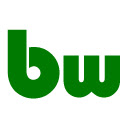
Technology used on website

Website schema(Structured data) analyzer
https://search.google.com/test/rich-results?url=https%3A%2F%2Fwww.fisherdesignandadvertising.com%2F

Website history
https://web.archive.org/web/*/fisherdesignandadvertising.com
Web design
Web design encompasses many different skills and disciplines in the production and maintenance of websites. The different areas of web design include web graphic design; user interface design (UI design); authoring, including standardised code and proprietary software; user experience design (UX design); and search engine optimization. Often many individuals will work in teams covering different aspects of the design process, although some designers will cover them all.[1] The term "web design" is normally used to describe the design process relating to the front-end (client side) design of a website including writing markup. Web design partially overlaps web engineering in the broader scope of web development. Web designers are expected to have an awareness of usability and be up to date with web accessibility guidelines.
History

1988–2001
Although web design has a fairly recent history, it can be linked to other areas such as graphic design, user experience, and multimedia arts, but is more aptly seen from a technological standpoint. It has become a large part of people's everyday lives. It is hard to imagine the Internet without animated graphics, different styles of typography, backgrounds, videos and music. The web was announced on August 6, 1991; in November 1992, CERN was the first website to go live on the World Wide Web. During this period, websites were structured by using the
Related disciplines
Notes
- ^
-based markup and spacer .GIF images
References
- ^ Jump up to:a b Lester, Georgina. "Different jobs and responsibilities of various people involved in creating a website". Arts Wales UK. Retrieved 2012-03-17.
- ^ CPBI, Ryan Shelley. "The History of Website Design: 30 Years of Building the Web [2022 Update]". smamarketing.net. Retrieved 2022-10-12.
- ^ "Longer Biography". Retrieved 2012-03-16.
- ^ "Mosaic Browser" (PDF). Archived from the original (PDF) on 2013-09-02. Retrieved 2012-03-16.
- ^ Zwicky, E.D; Cooper, S; Chapman, D.B. (2000). Building Internet Firewalls. United States: O'Reily & Associates. p. 804. ISBN 1-56592-871-7.
- ^ Jump up to:a b c d Niederst, Jennifer (2006). Web Design In a Nutshell. United States of America: O'Reilly Media. pp. 12–14. ISBN 0-596-00987-9.
- ^ Jump up to:a b Chapman, Cameron, The Evolution of Web Design, Six Revisions, archived from the original on 30 October 2013
- ^ "AMO.NET America's Multimedia Online (Internet Explorer 6 PREVIEW)". amo.net. Retrieved 2020-05-27.
- ^ Jump up to:a b "W3C Markup Validation Service".
- ^ W3C. "Web Accessibility Initiative (WAI)".
- ^ "What is Web Design?". The Interaction Design Foundation. Retrieved 2022-10-12.
- ^ THORLACIUS, LISBETH (2007). "The Role of Aesthetics in Web Design". Nordicom Review. 28 (28): 63–76. doi:10.1515/nor-2017-0201. S2CID 146649056.
- ^ "What is a Web Designer? (2022 Guide)". BrainStation®. Retrieved 2022-10-28.
- ^ Castañeda, J.A Francisco; Muñoz-Leiva, Teodoro Luque (2007). "Web Acceptance Model (WAM): Moderating effects of user experience". Information & Management. 44 (4): 384–396. doi:10.1016/j.im.2007.02.003.
- ^ "Building a resilient frontend using progressive enhancement". GOV.UK. Retrieved 27 October 2021.
- ^ "Rolling out mobile-first indexing". Official Google Webmaster Central Blog. Retrieved 2018-06-09.
- ^ Stone, John (2009-11-16). "20 Do's and Don'ts of Effective Web Typography". Retrieved 2012-03-19.
- ^ World Wide Web Consortium: Understanding Web Content Accessibility Guidelines 2.2.2: Pause, Stop, Hide
- ^ W3C QA. "My Web site is standard! And yours?". Retrieved 2012-03-21.
- ^ Christensen, Mathias Biilmann (2015-11-16). "Static Website Generators Reviewed: Jekyll, Middleman, Roots, Hugo". Smashing Magazine. Retrieved 2016-10-26.
- ^ Soucy, Kyle, Is Your Homepage Doing What It Should?, Usable Interface, archived from the original on 8 June 2012
- ^ Nielsen, Jakob (10 November 2003), The Ten Most Violated Homepage Design Guidelines, Nielsen Norman Group, archived from the original on 5 October 2013
- ^ Knight, Kayla (20 August 2009), Essential Tips for Designing an Effective Homepage, Six Revisions, archived from the original on 21 August 2013
- ^ Spool, Jared (29 September 2005), Is Home Page Design Relevant Anymore?, User Interface Engineering, archived from the original on 16 September 2013
- ^ Chapman, Cameron (15 September 2010), 10 Usability Tips Based on Research Studies, Six Revisions, archived from the original on 2 September 2013
- ^ Gócza, Zoltán, Myth #17: The homepage is your most important page, archived from the original on 2 June 2013
- ^ McGovern, Gerry (18 April 2010), The decline of the homepage, archived from the original on 24 May 2013
- ^ Porter, Joshua (24 April 2006), Prioritizing Design Time: A Long Tail Approach, User Interface Engineering, archived from the original on 14 May 2013
- ^ Spool, Jared (6 August 2007), Usability Tools Podcast: Home Page Design, archived from the original on 29 April 2013
- ^ Jump up to:a b Messner, Katie (22 April 2013), Image Carousels: Getting Control of the Merry-Go-Round, Usability.gov, archived from the original on 10 October 2013
- ^ Jones, Harrison (19 June 2013), Homepage Sliders: Bad For SEO, Bad For Usability, archived from the original on 22 November 2013
- ^ Laja, Peep (8 June 2019), Image Carousels and Sliders? Don't Use Them. (Here's why.), CXL, archived from the original on 10 December 2019
- ^ Oleksy, Walter (2001). Careers in Web Design. New York: The Rosen Publishing Group, Inc. pp. 9–11. ISBN 978-0-8239-3191-0.
- ^ Visser, Larno, et al. ChatGPT for Web Design : Create Amazing Websites. [First edition]., PACKT Publishing, 2023.
